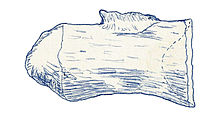Macrurosaurus
| Macrurosaurus | |
|---|---|

| |
| Vertebra of M. semnus | |
| Scientific classification | |
| Domain: | Eukaryota |
| Kingdom: | Animalia |
| Phylum: | Chordata |
| Clade: | Dinosauria |
| Clade: | Saurischia |
| Clade: | †Sauropodomorpha |
| Clade: | †Sauropoda |
| Clade: | †Macronaria |
| Clade: | † Titanosauriformes
|
| Genus: | †Macrurosaurus Seeley , 1869
|
| Type species | |
| †Macrurosaurus semnus Seeley, 1869
| |
| Other species | |
| |
| Synonyms | |
| |
Macrurosaurus (meaning "large-tailed lizard") is the name given to a
titanosauriform which lived in what is now England. The type species, M. semnus, was named in 1876.[1] A second species, M. platypus, may also exist.[2][3]
History
The genus Macrurosaurus was named by
Paul M. Barrett reviewed all Acanthopholis material. They concluded that all species were nomina dubia whose syntype specimens were composites of non-diagnostic ankylosaur and ornithopod remains. For example, the metatarsals included in the syntype series of Acanthopholis platypus are from a sauropod, but the remaining syntypes are not.[6]
Metatarsals
of M. platypusThe
Woodwardian Museum from William Farren who had it dug up at Coldhams Common near Barnwell. This series is made up of 25 proximal vertebrae. The second was found by Reverend W. Stokes-Shaw at a slightly more western location near Barton
. It contained fifteen smaller distal vertebrae, from the tail end. Seeley, acting on the presumption that both finds belonged to the same species if not individual, combined the two series into one tail of about 4.5 metres length.
Other fragmentary fossils from England (Acanthopholis platypus),[2] France and Argentina have later been referred to Macrurosaurus[8] but the identity is today doubted.[2]
A 2022 review considered Macrurosaurus to be an indeterminate macronarian, while "Acanthopholis" platypus was treated as indeterminate within Eusauropoda or Neosauropoda.[9]
Description
Macrurosaurus was by Seeley himself estimated to be about ten metres long. Often a length of around twelve metres (40 ft) is indicated in the popular literature. The
vertebrae in front are procoelous, meaning that the vertebral centra are hollow at the front end and convex at the back. Those behind are amphicoelous
: hollow at both ends. Seeley assumed that the full count of tail vertebrae would have been about fifty.
Classification
Macrurosaurus was by Seeley assigned to the
Titanosauriformes. Also it is today often seen as a nomen dubium
.
References
- ^
- ^ S2CID 129277596.
- ^ a b von Huene, F. (1956) "Palaeontologie und Phylogenie der niederen Tetrapoden"
- ISSN 0374-5481.
- ISSN 0374-5481.
- ^ Superbiola, X.P.; Barrett, P.M. (1999). "A systematic review of ankylosaurian dinosaur remains from the Albian-Cenomanian of England". Special Papers in Palaeontology. 60: 177–208.
- ISBN 1-86239-143-2.
- ^ F. v. Huene. 1927. Contribución a la paleogeografía de Sud América [Contribution to the paleogeography of South America]. Boletín de la Academia Nacional de Ciencias de la República Argentina 30:231-294
- PMID 35845848.
- ^ R. Lydekker. 1888. Catalogue of the Fossil Reptilia and Amphibia in the British Museum (Natural History). Part I. Containing the Orders Ornithosauria, Crocodilia, Dinosauria, Squamata, Rhynchocephalia, and Proterosauria. British Museum (Natural History), London 1-309
- ^ F. v. Huene, 1929, "Los sauriquios y ornitisquios del Cretáceo argentino", Anales del Museo de La Plata, serie 2 3: 1-196
